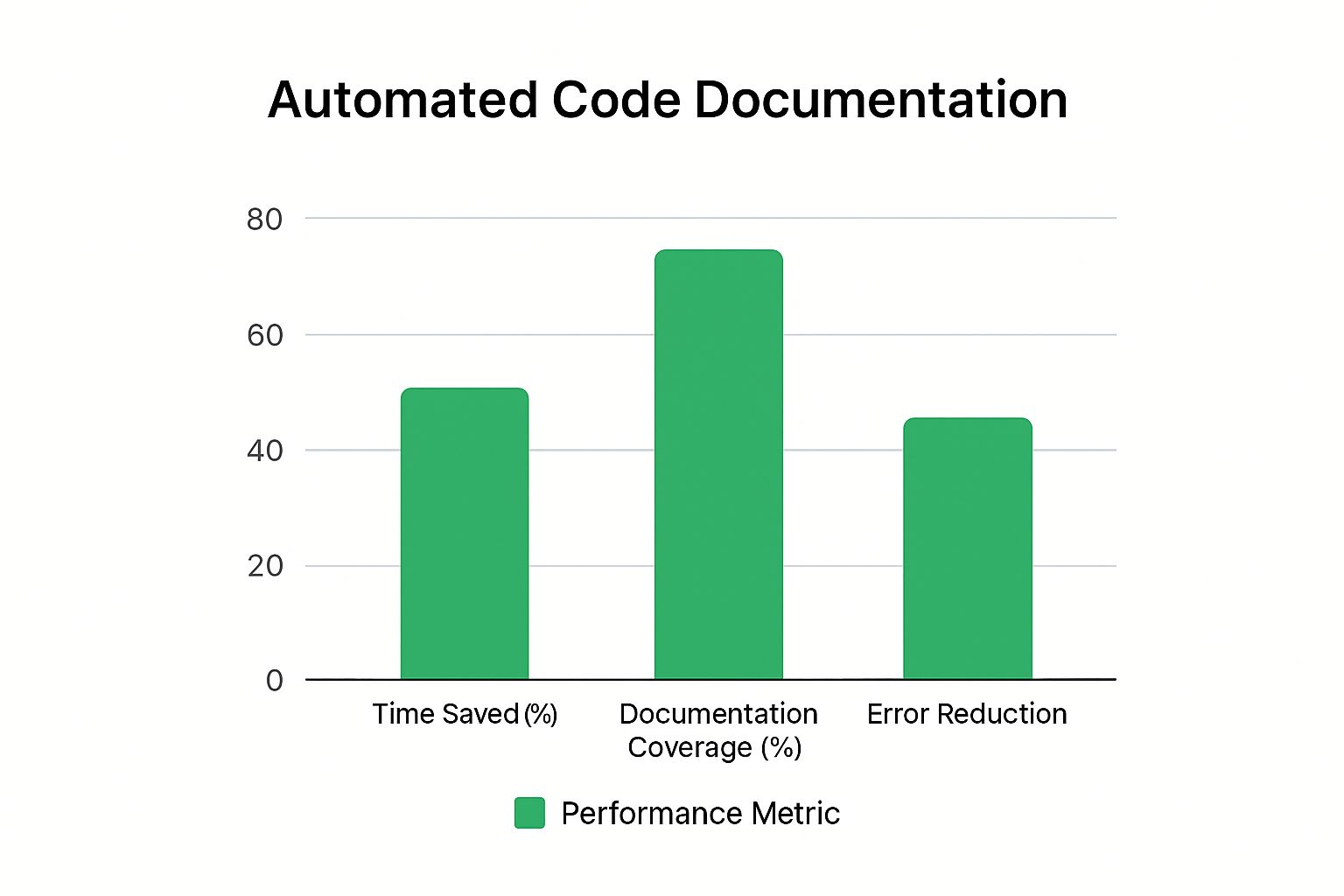Discover how automated code documentation with AI tools can streamline your workflow and improve collaboration. Learn more today!
The software development landscape is constantly evolving. New tools and frameworks appear regularly, demanding teams to work faster and smarter. In this fast-paced environment, relying on manual code documentation is no longer efficient. It slows down productivity, creates inconsistencies, and hinders a team’s ability to adapt and grow. Embracing automated code documentation isn’t just a modern trend; it’s essential for staying competitive.
Manual documentation is prone to human error. Under pressure to meet deadlines, developers often treat documentation as a secondary task. This results in incomplete, inaccurate, or even absent documentation. Maintaining manual documentation across large codebases is also a significant burden, consuming valuable developer time that could be used for development and innovation. Outdated documentation becomes a source of frustration for anyone who relies on it.
This is where automated code documentation excels. Tools like DocuWriter.ai use AI and algorithms to analyze code in real-time, automatically generating accurate and consistent documentation. These tools integrate directly into workflows, creating documentation as code is written or modified. This frees developers from the tedious task of manual documentation, allowing them to concentrate on writing code.
The market has recognized the value of these tools. The AI code tools market, including automated documentation systems, is projected to reach US****6.7 billion valuation in 2024, representing a CAGR of 25.2%. For more detailed statistics, see the Artificial Intelligence Code Tools Research Report.
Automated code documentation significantly impacts developer morale and team dynamics. Manual documentation is often seen as a chore, impacting motivation and contributing to burnout. Automated solutions, however, empower developers to focus on creative problem-solving and innovation, fostering a more positive and productive environment.
Companies that resist the shift toward automated code documentation risk falling behind. In a competitive market where speed and agility are crucial, manual processes become a major disadvantage. Automated documentation allows teams to move faster, iterate more efficiently, and adapt to changing market needs. This translates to faster release cycles, improved product quality, and a stronger competitive edge. By adopting automated documentation, teams are not simply improving a process; they are investing in their future success.
Automated code documentation offers more than just time savings. It fundamentally changes how teams operate, fostering better communication, collaboration, and higher overall code quality. These improvements create tangible benefits that impact the entire development lifecycle, from onboarding new team members to reducing technical debt.
One significant advantage is the elimination of knowledge silos. With automated and readily available documentation, every team member can access the same information. This reduces the reliance on specific individuals for explanations of complex code sections. It also streamlines onboarding. New hires can quickly get up to speed with the automated documentation and become productive much faster.
Automated documentation also reduces the cognitive load on senior developers. They no longer need to spend excessive time explaining code intricacies or answering repetitive questions. This frees them to focus on more complex tasks, driving innovation and improving the team’s overall efficiency. These often overlooked benefits contribute significantly to a more harmonious and productive work environment.
Automated documentation plays a vital role in improving code review quality. With consistent and up-to-date documentation easily accessible, reviewers can focus on the code’s logic and architecture instead of deciphering its purpose. This leads to more effective code reviews, catching potential issues early and ensuring higher code quality.
This improved understanding also fosters better technical decision-making. With a clear picture of the codebase, teams can make informed decisions about future development, minimizing the risk of technical debt or architectural inconsistencies. Furthermore, these tools transform team dynamics. Improved communication, fostered by accessible documentation, reduces misunderstandings and promotes smoother collaboration between developers.
This benefit extends to collaboration between technical and non-technical stakeholders. Clear, automated documentation provides a shared project understanding, facilitating communication and alignment across departments. Transitioning from manual to automated documentation requires understanding established principles. For guidance, explore these resources on code documentation best practices.
The positive impact of automated code documentation extends to the codebase itself. By providing a clear and consistent view of the code’s structure and function, these tools encourage better architectural practices. This leads to more maintainable code, reducing technical debt and making future development smoother and more predictable.
The projected growth of the AI code tool market underscores the importance of automated documentation. By 2025, the market size is expected to reach USD 15.11 billion, escalating to approximately USD 99.10 billion by 2034, reflecting a CAGR of 23.24%. This growth aligns with the increasing integration of AI in development, where automated documentation creates real-time, accurate, and consistent documentation. Find more detailed statistics here.
Finally, automated code documentation significantly impacts developer satisfaction and retention. By eliminating tedious tasks and fostering a more collaborative and efficient environment, these tools improve morale and job satisfaction. Forward-thinking managers recognize this and are using automated documentation to attract and retain top talent. You might be interested in: How to master code documentation best practices. Improved developer satisfaction translates into increased productivity and higher quality work, further reinforcing the value of automated code documentation.


Picking the perfect automated code documentation tool can be tricky. With so many options, it’s important to look past the marketing hype and find tools that truly improve your development process. This means understanding the strengths, weaknesses, and best use cases for each platform.
Choosing the right automated documentation tool requires careful thought. Team size and project complexity are key factors. A simple tool might work for smaller teams, while larger projects might need a more powerful platform. Your current development setup and future growth plans also matter. For example, a fast-growing startup might want a tool that integrates easily and scales well.
Language support is essential. Make sure the tool works with the programming languages you use. Integration complexity is also important. A difficult integration can slow down adoption and make the tool less effective. Finally, pricing is a big consideration. Look at the long-term costs and pick a pricing model that fits your budget.
There are automated documentation tools for every need. Some lightweight options are perfect for small teams that want basic automated documentation. These tools are usually easy to use and set up. For larger organizations, enterprise-grade platforms handle complex compliance rules and integrate with advanced workflows. These platforms offer advanced features like real-time documentation, version control, and collaborative editing. To help visualize the range of options, let’s look at a comparison:
To understand the available options better, we’ve compiled a comparison of various automated documentation tools:
Automated Documentation Tools That Teams Actually Use Real-world comparison of leading automated code documentation platforms based on user satisfaction, integration ease, and measurable outcomes
This table provides a quick overview of just some of the tools on the market. The “Best For” column emphasizes each platform’s specific strength, allowing you to more quickly match tools to your particular needs.
Features aren’t everything. Think about how easy it is to learn a new tool. A steep learning curve can slow down your team. Ongoing maintenance is also a factor. Some tools need a lot of upkeep, while others are more hands-off. A tool with an easy learning curve and minimal maintenance will help your team get started quickly and see long-term benefits.
DocuWriter.ai uses AI to automate code and API documentation, saving developers time. This lets teams focus on writing great code while ensuring accurate and consistent documentation. DocuWriter.ai also offers features like UML diagram generation and code refactoring support, making development even more efficient.
Finding the right automated documentation tool means matching your team’s needs to the right platform. Consider things like integration complexity, language support, and maintenance. By carefully evaluating these factors, teams can choose a tool that improves their workflow and code quality. This leads to long-term success.

Implementing automated code documentation tools effectively is key to maximizing their value. Many teams face initial challenges, but learning from successful implementations can smooth the adoption process. For helpful strategies, consider looking into established documentation practices, such as those detailed in Haekka’s documentation.
A gradual rollout is often better than a sudden, big-bang implementation. Starting with a pilot project on a smaller codebase section lets teams test the tool, find issues, and refine processes before a company-wide rollout. This minimizes disruption and allows for continuous feedback and improvement.
For example, a team might automate documentation for a single module or service first. This focused approach allows them to understand the tool’s complexities and adapt it to their specific needs without overwhelming the team. A gradual rollout also helps identify and address resistance from team members hesitant about new tools.
Resistance to new tools is normal. Addressing concerns proactively is vital. This means clear communication about the benefits of automated code documentation, offering training, and actively soliciting team feedback. Showing how the tool improves daily workflows and reduces tedious tasks can be highly motivating.
Identifying key team members and involving them in the implementation process can also build buy-in and encourage wider adoption. These champions can then help colleagues understand and use the tool, fostering ownership and increasing the chances of a successful implementation.
Tracking the right metrics demonstrates the tool’s value. Key metrics include time saved on documentation, increased documentation coverage, and fewer code-related issues. Regular monitoring showcases the return on investment and justifies continued use and expansion within the organization.
Tracking time spent on documentation before and after implementation offers concrete proof of time savings. Monitoring code-related issues shows how improved documentation leads to fewer bugs and errors.
High-performing teams customize automated documentation tools to match their workflows. This involves configuring the tool to align with their coding style, documentation preferences, and specific project requirements. Establishing documentation standards ensures consistency across the codebase, improving readability and maintainability.
This might involve creating templates for different code elements or integrating the tool with version control systems like Git. Finding a balance between customization and standardization maximizes efficiency. In healthcare, technology significantly impacts documentation. For instance, the computer-assisted coding (CAC) software market was valued at USD 5.4 billion in 2024 and is projected to reach USD 15.8 billion by 2035, a CAGR of 10.3%. CAC uses AI and natural language processing (NLP) to automate medical code assignments, improving accuracy and efficiency in billing and regulatory compliance. You can explore more about efficient code documentation in our guide.
Initial enthusiasm for new tools can fade. Maintaining momentum requires ongoing effort. This includes regularly communicating the tool’s benefits, providing continued training and support, and establishing feedback channels for improvements.
Continuously refining processes and adapting to changing needs ensures automated code documentation remains valuable. This might involve periodic reviews of documentation standards, exploring new tool features and updates, and encouraging teams to share best practices.
Automated code documentation offers benefits across the board, but its specialized applications bring significant value to various sectors. This is particularly true for industries like healthcare and finance, where regulatory compliance is essential. These industries are adopting automated documentation to maintain development speed while adhering to stringent regulations.
Fintech companies face intense regulatory scrutiny. Automated code documentation proves invaluable in meeting audit requirements. Generating comprehensive documentation for data flow and security protocols, for example, can significantly streamline the audit process. This not only saves time but also mitigates the risk of penalties for non-compliance.
Automated tools ensure that documentation aligns with specific regulatory frameworks, providing a clear audit trail and demonstrating a commitment to best practices. This proactive approach fosters trust with regulators and bolsters the company’s reputation for security and compliance.
Healthcare organizations deal with the specific challenge of HIPAA compliance. Automated documentation tools are key to maintaining patient data privacy and security. They can automatically generate documentation that tracks access to sensitive information, ensuring adherence to HIPAA regulations.
These tools also simplify audits by providing easily accessible, comprehensive records of data handling procedures. This lessens the burden on healthcare professionals, allowing them to prioritize patient care. This focus on compliance through automation becomes even more crucial with the increasing digitization of healthcare records and the growing need for system interoperability.
In manufacturing, automated code documentation seamlessly integrates with quality management systems (QMS). These systems demand meticulous documentation of every stage, from design and development to testing and deployment.
Automated tools aid this process by generating comprehensive documentation that meets industry standards like ISO 9001. This ensures consistent documentation practices across the organization, enhancing quality control and minimizing errors and inconsistencies. Moreover, readily available documentation enables faster troubleshooting and more effective root cause analysis when production issues arise.
Each industry faces unique documentation challenges. Financial institutions, for instance, require tools that produce detailed reports for regulatory compliance, while manufacturing companies need documentation that integrates with their QMS. Understanding these nuances allows companies to select the tools that best address their specific requirements.
Forward-thinking organizations are discovering innovative ways to use automated documentation, going beyond basic code comments. They are integrating it into broader business processes, such as compliance reporting and knowledge management. This leads to greater efficiency and strengthens their competitive edge. This approach elevates documentation from a supporting function to a strategic asset, enabling companies to adapt to evolving regulations and market demands. This adaptability is vital for sustained success in today’s dynamic business environment. They are utilizing automated documentation not just to fulfill requirements, but as a proactive strategy to enhance processes and gain a competitive advantage.
Demonstrating the return on investment (ROI) of automated code documentation is key to getting stakeholders on board. While developers understand the benefits, presenting them financially to management requires a strategic approach. This means focusing on the metrics that resonate with different stakeholder groups, from engineering managers to CFOs.
Measuring ROI effectively begins with establishing clear baseline metrics. Before automating your documentation, track key performance indicators (KPIs) like time spent on manual documentation, documentation coverage, and the number of code-related issues caused by poor documentation. These baseline measurements provide a benchmark for comparing improvements after implementing automated documentation tools.
Tracking the right KPIs after implementation is equally crucial. For engineering managers, show improvements in developer productivity by highlighting the time saved through automation. For CFOs, emphasize reductions in maintenance costs and the money saved by avoiding bugs caused by inadequate documentation.

This infographic visualizes the impact of automated code documentation across three key metrics: Time Saved, Documentation Coverage, and Error Reduction. The data shows how automated documentation significantly improves efficiency and quality. The increase in Documentation Coverage and the decrease in Error Reduction translate into cost savings and improved development speed.
To further illustrate the impact of automated documentation, let’s examine some specific metrics:
The following table provides a detailed breakdown of key metrics and how they contribute to demonstrating the ROI of automated documentation:
Metrics That Prove Automated Documentation Success
Essential KPIs and measurement approaches for demonstrating the business impact and ROI of automated code documentation investments
This table summarizes the key metrics for measuring the success of automated documentation initiatives. Tracking these metrics and presenting them clearly to stakeholders can effectively demonstrate ROI and justify further investment in these tools.
Quantifiable metrics like time saved and error reduction are important. However, don’t forget the indirect benefits contributing to long-term success. Improved developer satisfaction, for instance, leads to better talent retention and higher quality work. While harder to quantify, these factors significantly impact team performance and project outcomes.
Automated documentation also simplifies onboarding new team members, reducing their time to productivity. This means faster project ramp-up and quicker time-to-market for new features.
Communicating ROI effectively means tailoring your message to each stakeholder group. Emphasize time saved and tedious task reduction for developers. For management, highlight the financial impact of improved efficiency, reduced maintenance costs, and faster time-to-market.
Present ROI calculations clearly and concisely, using visuals like charts and graphs. Real-world examples of companies successfully using these tools, like Amazon Q Developer, which offers automated documentation generation and code reviews, further strengthens your case. This automation allows teams to focus on building software instead of manual processes.
When requesting more investment in automated documentation tools, focus on the long-term advantages. Show how better documentation practices create a more robust and maintainable codebase. This reduces technical debt and enables faster future development cycles.
By demonstrating the positive impact of automated documentation on current projects and future growth, you build a compelling case for continued investment, ensuring your team has the resources to succeed. This proactive approach to documentation positions your organization for greater agility and long-term success.
Ready to improve your team’s code documentation? This section offers a practical guide to transitioning from current documentation challenges to a more efficient and effective future. We’ll explore pilot project strategies, criteria for evaluating automated documentation tools, and realistic timelines for achieving tangible results.
Starting small is crucial. Instead of a company-wide rollout, begin with a pilot project focused on a specific module or microservice. This targeted approach minimizes disruption and allows you to refine the process before scaling up. For example, a team might select a well-defined service with existing documentation to directly compare manual and automated processes.